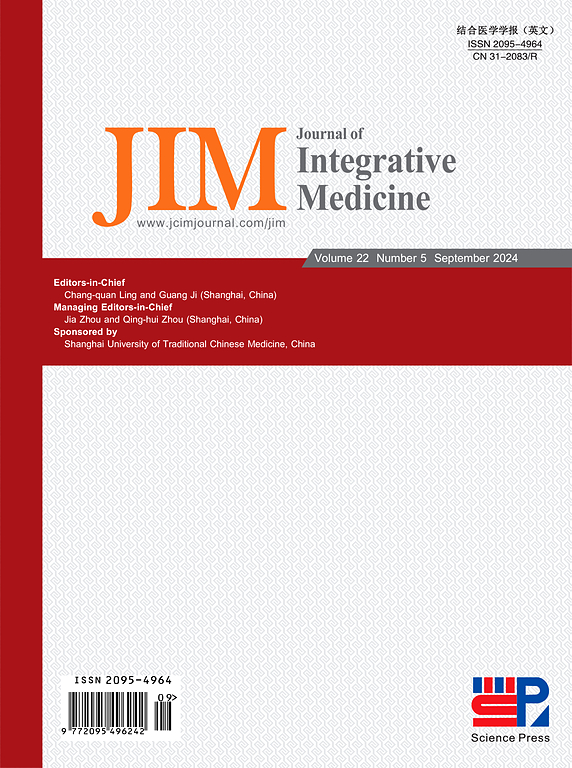Three-dimensional kinematic analysis can improve the efficacy of acupoint selection for post-stroke patients with upper limb spastic paresis: A randomized controlled trial
IF 4
2区 医学
Q1 INTEGRATIVE & COMPLEMENTARY MEDICINE
引用次数: 0
Abstract
Background
China is seeing a growing demand for rehabilitation treatments for post-stroke upper limb spastic paresis (PSSP-UL). Although acupuncture is known to be effective for PSSP-UL, there is room to enhance its efficacy.
Objective
This study explored a semi-personalized acupuncture approach for PSSP-UL that used three-dimensional kinematic analysis (3DKA) results to select additional acupoints, and investigated the feasibility, efficacy and safety of this approach.
Design, setting, participants and interventions
This single-blind, single-center, randomized, controlled trial involved 74 participants who experienced a first-ever ischemic or hemorrhagic stroke with spastic upper limb paresis. The participants were then randomly assigned to the intervention group or the control group in a 1:1 ratio. Both groups received conventional treatments and acupuncture treatment 5 days a week for 4 weeks. The main acupoints in both groups were the same, while participants in the intervention group received additional acupoints selected on the basis of 3DKA results. Follow-up assessments were conducted for 8 weeks after the treatment.
Main outcome measures
The primary outcome was the Fugl-Meyer Assessment for Upper Extremity (FMA-UE) response rate (≥ 6-point change) at week 4. Secondary outcomes included changes in motor function (FMA-UE), Brunnstrom recovery stage (BRS), manual muscle test (MMT), spasticity (Modified Ashworth Scale, MAS), and activities of daily life (Modified Barthel Index, MBI) at week 4 and week 12.
Results
Sixty-four participants completed the trial and underwent analyses. Compared with control group, the intervention group exhibited a significantly higher FMA-UE response rate at week 4 (χ2 = 5.479, P = 0.019) and greater improvements in FMA-UE at both week 4 and week 12 (both P < 0.001). The intervention group also showed bigger improvements from baseline in the MMT grades for shoulder adduction and elbow flexion at weeks 4 and 12 as well as thumb adduction at week 4 (P = 0.007, P = 0.049, P = 0.019, P = 0.008, P = 0.029, respectively). The intervention group showed a better change in the MBI at both week 4 and week 12 (P = 0.004 and P = 0.010, respectively). Although the intervention group had a higher BRS for the hand at week 12 (P = 0.041), no intergroup differences were observed at week 4 (all P > 0.05). The two groups showed no differences in MAS grades as well as in BRS for the arm at weeks 4 and 12 (all P > 0.05).
Conclusion
Semi-personalized acupuncture prescription based on 3DKA results significantly improved motor function, muscle strength, and activities of daily living in patients with PSSP-UL.
Trial registration
Chinese Clinical Trial Registry ChiCTR2200056216.
Please cite this article as: Huang XY, Liao OP, Jiang SY, Tao JM, Li Y, Lu XY, Li YY, Wang C, Li J, Ma XP. Three-dimensional kinematic analysis can improve the efficacy of acupoint selection for post-stroke patients with upper limb spastic paresis: A randomized controlled trial. J Integr Med. 2025; 23(1): 15–24.
三维运动学分析可提高脑卒中后上肢痉挛性瘫患者取穴的疗效:一项随机对照试验。
背景:中国对脑卒中后上肢痉挛性轻瘫(PSSP-UL)康复治疗的需求日益增长。虽然已知针灸对psp - ul有效,但仍有提高其疗效的空间。目的:探索一种利用三维运动学分析(3DKA)结果选择附加穴位治疗PSSP-UL的半个性化针刺方法,并探讨该方法的可行性、有效性和安全性。设计、环境、参与者和干预措施:这项单盲、单中心、随机对照试验涉及74名首次经历缺血性或出血性中风并痉挛性上肢麻痹的参与者。然后参与者按1:1的比例随机分配到干预组或对照组。两组均给予常规治疗和针灸治疗,每周5天,连续4周。两组主要穴位相同,干预组根据3DKA结果选择额外穴位。治疗后随访8周。主要结局指标:主要结局指标为第4周Fugl-Meyer上肢反应率评估(FMA-UE)(≥6点变化)。次要结果包括运动功能(FMA-UE)、Brunnstrom恢复阶段(BRS)、手动肌肉测试(MMT)、痉挛(改良Ashworth量表,MAS)和日常生活活动(改良Barthel指数,MBI)在第4周和第12周的变化。结果:64名参与者完成了试验并进行了分析。与对照组相比,干预组在第4周的FMA-UE缓解率显著高于对照组(χ2 = 5.479, P = 0.019),在第4周和第12周的FMA-UE改善更大(P均< 0.001)。干预组在第4周和第12周的肩部内收和肘关节屈曲以及第4周的拇指内收的MMT评分也比基线有更大的改善(P = 0.007, P = 0.049, P = 0.019, P = 0.008, P = 0.029)。干预组在第4周和第12周的MBI变化更好(P = 0.004和P = 0.010)。虽然干预组在第12周的手部BRS较高(P = 0.041),但在第4周没有观察到组间差异(P均为0.05)。两组患者在第4周和第12周的MAS分级和BRS均无差异(P < 0.05)。结论:基于3DKA结果的半个性化针刺处方可显著改善PSSP-UL患者的运动功能、肌力和日常生活活动能力。试验注册:中国临床试验注册中心ChiCTR2200056216。本文署名:黄晓霞,廖爱普,姜世义,陶建民,李毅,吕晓霞,李云云,王超,李军,马晓平。三维运动学分析可提高脑卒中后上肢痉挛性瘫患者取穴的疗效:一项随机对照试验。集成医学[J];打印前Epub。
本文章由计算机程序翻译,如有差异,请以英文原文为准。
求助全文
约1分钟内获得全文
求助全文
来源期刊

Journal of Integrative Medicine-Jim
Medicine-Complementary and Alternative Medicine
CiteScore
9.20
自引率
4.20%
发文量
3319
期刊介绍:
The predecessor of JIM is the Journal of Chinese Integrative Medicine (Zhong Xi Yi Jie He Xue Bao). With this new, English-language publication, we are committed to make JIM an international platform for publishing high-quality papers on complementary and alternative medicine (CAM) and an open forum in which the different professions and international scholarly communities can exchange views, share research and their clinical experience, discuss CAM education, and confer about issues and problems in our various disciplines and in CAM as a whole in order to promote integrative medicine.
JIM is indexed/abstracted in: MEDLINE/PubMed, ScienceDirect, Emerging Sources Citation Index (ESCI), Scopus, Embase, Chemical Abstracts (CA), CAB Abstracts, EBSCO, WPRIM, JST China, Chinese Science Citation Database (CSCD), and China National Knowledge Infrastructure (CNKI).
JIM Editorial Office uses ThomsonReuters ScholarOne Manuscripts as submitting and review system (submission link: http://mc03.manuscriptcentral.com/jcim-en).
JIM is published bimonthly. Manuscripts submitted to JIM should be written in English. Article types include but are not limited to randomized controlled and pragmatic trials, translational and patient-centered effectiveness outcome studies, case series and reports, clinical trial protocols, preclinical and basic science studies, systematic reviews and meta-analyses, papers on methodology and CAM history or education, conference proceedings, editorials, commentaries, short communications, book reviews, and letters to the editor.
Our purpose is to publish a prestigious international journal for studies in integrative medicine. To achieve this aim, we seek to publish high-quality papers on any aspects of integrative medicine, such as acupuncture and traditional Chinese medicine, Ayurveda medicine, herbal medicine, homeopathy, nutrition, chiropractic, mind-body medicine, taichi, qigong, meditation, and any other modalities of CAM; our commitment to international scope ensures that research and progress from all regions of the world are widely covered. These ensure that articles published in JIM have the maximum exposure to the international scholarly community.
JIM can help its authors let their papers reach the widest possible range of readers, and let all those who share an interest in their research field be concerned with their study.
 求助内容:
求助内容: 应助结果提醒方式:
应助结果提醒方式:


